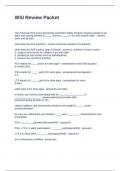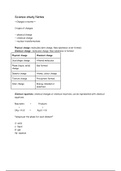Psychology of Language (800144-B-6)
Summary of the material discussed during lectures
Study year 2021-2022
,Psychology of Language Lecture 01-09
Defining language
A system of form-meaning pairings that can be used to intentionally communicate meaning
System → there is structure to the madness
Form-meaning pairings → of different sizes, at various levels of specificity
Use → different modalities, production and perception
Intentionally → producer wants to achieve something
Communicate meaning → various communicative goals
Language as a system
Usually thought of as ‘rules’, but (psycho)linguists are not prescriptivists. We describe and try
to understand and perhaps predict systematicities at different levels:
- Sounds
- Words
- Phrases
- Clauses
- Sentences
- Discourse
Form-meaning pairings
The intuitive form-meaning unit is a word, but we will see that there are units of different
sizes:
- ‘un’ in unpleasant
- Work hard, strong coffee (and not work strong, hard coffee)
- The X-er the Y-er (the sooner the better, the more you pay attention, the more you’ll
remember)
Language use
Language is spoken and heard, signed and seen, and written and read
Language is acquired, learned, and sometimes forgotten or lost
Communicating meaning
We use language to exchange information, to express emotions, to convince others
This makes language very relevant for students of communication sciences
Linguistics – the study of language
Language can be studied a number of different ways, at different levels and with different
focus
- Phonetics → the study of raw sounds
- Phonology → the study of how sounds are used within a language
- Morphology → the study of words and word formation
- Semantics → the study of meaning
- Syntax → the study of word order
- Pragmatics
- …
,THE BOOK
a. The big picture
Intro, origins of language, language and the brain CH1-3
b. Language acquisition
Sounds, words, sentences CH4-6
c. Adult language use
Perception and production, sounds, words, sentences, discourse CH7-11
d. Language in use CH12
Exam mc and two open questions on the end
2 assignments 20%
1 exam 60%
Ass1 → acquisition/development
Ass2 → speech.. (?)
, Psychology of Language Lecture 2 – The Origins of Human Language
Is language uniquely human?
Are humans hardwired for language?
How do languages develop?
No Scientific Agreement
Uniquely to humans, hardwired?
Nativism in the Field of Psycholinguistics
Not only are humans genetically programmed to have a general capacity for language,
particular aspects of language ability are also genetically specified.
→ the yes + yes combination in the table
Is language uniquely human?
- Depends on what you define as ‘language’
- Lots of studies looking at animals (birds, bees, dolphins, primates)
Different songs from birds for example
Differences Between Apes and Human
What we attribute to primates/other animals, be careful!
linguistic ability we attribute to primates is often in the eye of the beyolder → we tend to see
them more human-like than they actually are
- Universal acquisition in children → variable acquisition in apes
- Children experiment and innovate → apes copy
- Children babble → apes don’t
- As utterances grow longer:
o In children → grammar becomes more complex
o In apes → signs are repeated
Children try new constructions, apes don’t, they just imitate
- Humans apply grammatical rules consistently → apes apply grammatical rules
inconsistently
- Humans use words to comment and express intentions → apes use signs as tools to get
things (up to 96% of signs are requests)
- Apes interrupt far more than humans
Summary of the material discussed during lectures
Study year 2021-2022
,Psychology of Language Lecture 01-09
Defining language
A system of form-meaning pairings that can be used to intentionally communicate meaning
System → there is structure to the madness
Form-meaning pairings → of different sizes, at various levels of specificity
Use → different modalities, production and perception
Intentionally → producer wants to achieve something
Communicate meaning → various communicative goals
Language as a system
Usually thought of as ‘rules’, but (psycho)linguists are not prescriptivists. We describe and try
to understand and perhaps predict systematicities at different levels:
- Sounds
- Words
- Phrases
- Clauses
- Sentences
- Discourse
Form-meaning pairings
The intuitive form-meaning unit is a word, but we will see that there are units of different
sizes:
- ‘un’ in unpleasant
- Work hard, strong coffee (and not work strong, hard coffee)
- The X-er the Y-er (the sooner the better, the more you pay attention, the more you’ll
remember)
Language use
Language is spoken and heard, signed and seen, and written and read
Language is acquired, learned, and sometimes forgotten or lost
Communicating meaning
We use language to exchange information, to express emotions, to convince others
This makes language very relevant for students of communication sciences
Linguistics – the study of language
Language can be studied a number of different ways, at different levels and with different
focus
- Phonetics → the study of raw sounds
- Phonology → the study of how sounds are used within a language
- Morphology → the study of words and word formation
- Semantics → the study of meaning
- Syntax → the study of word order
- Pragmatics
- …
,THE BOOK
a. The big picture
Intro, origins of language, language and the brain CH1-3
b. Language acquisition
Sounds, words, sentences CH4-6
c. Adult language use
Perception and production, sounds, words, sentences, discourse CH7-11
d. Language in use CH12
Exam mc and two open questions on the end
2 assignments 20%
1 exam 60%
Ass1 → acquisition/development
Ass2 → speech.. (?)
, Psychology of Language Lecture 2 – The Origins of Human Language
Is language uniquely human?
Are humans hardwired for language?
How do languages develop?
No Scientific Agreement
Uniquely to humans, hardwired?
Nativism in the Field of Psycholinguistics
Not only are humans genetically programmed to have a general capacity for language,
particular aspects of language ability are also genetically specified.
→ the yes + yes combination in the table
Is language uniquely human?
- Depends on what you define as ‘language’
- Lots of studies looking at animals (birds, bees, dolphins, primates)
Different songs from birds for example
Differences Between Apes and Human
What we attribute to primates/other animals, be careful!
linguistic ability we attribute to primates is often in the eye of the beyolder → we tend to see
them more human-like than they actually are
- Universal acquisition in children → variable acquisition in apes
- Children experiment and innovate → apes copy
- Children babble → apes don’t
- As utterances grow longer:
o In children → grammar becomes more complex
o In apes → signs are repeated
Children try new constructions, apes don’t, they just imitate
- Humans apply grammatical rules consistently → apes apply grammatical rules
inconsistently
- Humans use words to comment and express intentions → apes use signs as tools to get
things (up to 96% of signs are requests)
- Apes interrupt far more than humans










